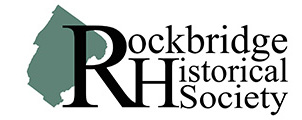World War 1 and Rockbridge
This centennial exhibit highlights more local dimensions to the global conflict that has been revisited, these past four years, through a number of important statewide, national, and international World War 1 Commissions. The strength of what we have to offer draws not just on 80 years of RHS Collections, but on generous loans from some of our key organizational partners: including the George C. Marshall Museum, Virginia Military Institute, and Washington and Lee University, as well as other individual donors.
On arrival, visitors may be initially drawn to some of the biographical portraits of some of the War’s more notable legends, while learning more about their varied ties to our area. A series of panels spotlight the VMI training and early military careers of Generals Marshall and Patton; legendary aviator Kiffin Rockwell; and William Couper: acclaimed engineer, historian of the VMI, and a onetime President of the Rockbridge Historical Society.
Also gracing the walls are letters and postcards, scrapbooks from the field, and composite photographs of the early volunteer members of the W&L Ambulance Corps. Other accounts witness the extraordinary number of VMI alumni who served; over 90% of those between ages 18-40 served in some capacity or another. A photographic collage of tombstones in Lexington’s Evergreen Cemetery also bears witness to the number of local African-American men who served in Europe and in the United States, whose service was critical for both the French and American armies, even while still fighting the constraints of segregation and Jim Crow.

Loans on Display from George C. Marshall Library and Museum
In RHS’ newly constructed display cabinets, some of the more arresting artifacts include sidearms carried by both American and German soldiers, and the Doughboy and Pickelhaube helmets they wore; uniforms worn and banners borne by the 80th Blue Ridge Division; diaries and postcards sent home by enlisted men to their Rockbridge families and sweethearts; a gas mask, razor kit, lighter with trench art, and treasured tobacco; colorful U.S. Victory Medals and Croix de Guerre duly awarded by both American and French armies; and a vivid first-person account of the Armistice cease-fire, as recorded by Covington’s Homer Simpson.
On the homefront, original propaganda posters brightly flog War Bonds during and Victory Loans after the War, along with templates for speeches to be given by “Four Minute Men” recruited to publicly promote and sell them in Rockbridge. One section draws on a previous RHS program that detailed the contemporary Influenza epidemic (Buena Vista was especially hard hit), as well as local public health measures and medical attempts to treat the outbreak that claimed 100,000,000 lives globally.
Other wartime items represent the War’s shadow on different county, city, and African-American schools, alongside local activist Eliza Walker’s ‘Colored Soldiers Appeal:’ a postcard campaign selling memorial blocks to help fund the ‘Colored Old Folks Home and Orphanage’ in Lexington. Paired with a an early 20th century telephone, its ear cone silently waiting for news these everyday mementos humbly but tellingly testify to citizens’ commitments and care for Rockbridge generations ahead.

Credit: W&L Special Collections
The exhibit will continue through the first half of 2019. During that time, our centennial witness will extend to the point where most area soldiers had returned to Rockbridge, and to the landmark if fragile agreements to the Treaty of Versailles, signed on June 28, 1919 (five years to the day when the assassination of Archduke Ferdinand, in seemingly remote Sarajevo, would set the world on fire).
We are planning additional events through the winter, spring, and summer, including a new themed walking tour of relevant sidewalk pavers commemorating ‘The Righteous and Rascals of Rockbridge.’ Another initiative looks to develop a cross-generational film series centered on WW1: including Sgt. Stubby (a recently released animated children’s film celebrating a decorated dog) who survived the battlefront) and Wings (starring Gary Cooper, and the first movie to win an Academy Award for Best Picture, thanks to its groundbreaking sequences in capturing early military aviation). We also look forward to affirming our educational outreach through a panel drawing on the perspectives of VMI History faculty, staff from the Institute’s Center for Leadership and Ethics, and cadets who prepared some of the interpretive panels honoring their VMI predecessors, now hanging in our Remsburg Gallery.

As we welcome visitors to this centennial exhibit, we also invite your own contributions. You can help meaningfully enrich RHS mission and legacy by sharing conversation and keepsakes – or even contributing to their preservation in our archives. Your own photographs, letters and stories from local families with ties to WW1 can help us add new perspectives as we rotate materials in the months ahead; as can period artifacts that illuminate the habits of everyday life in Rockbridge during the 1910s, and the years in the Great War’s wake.




